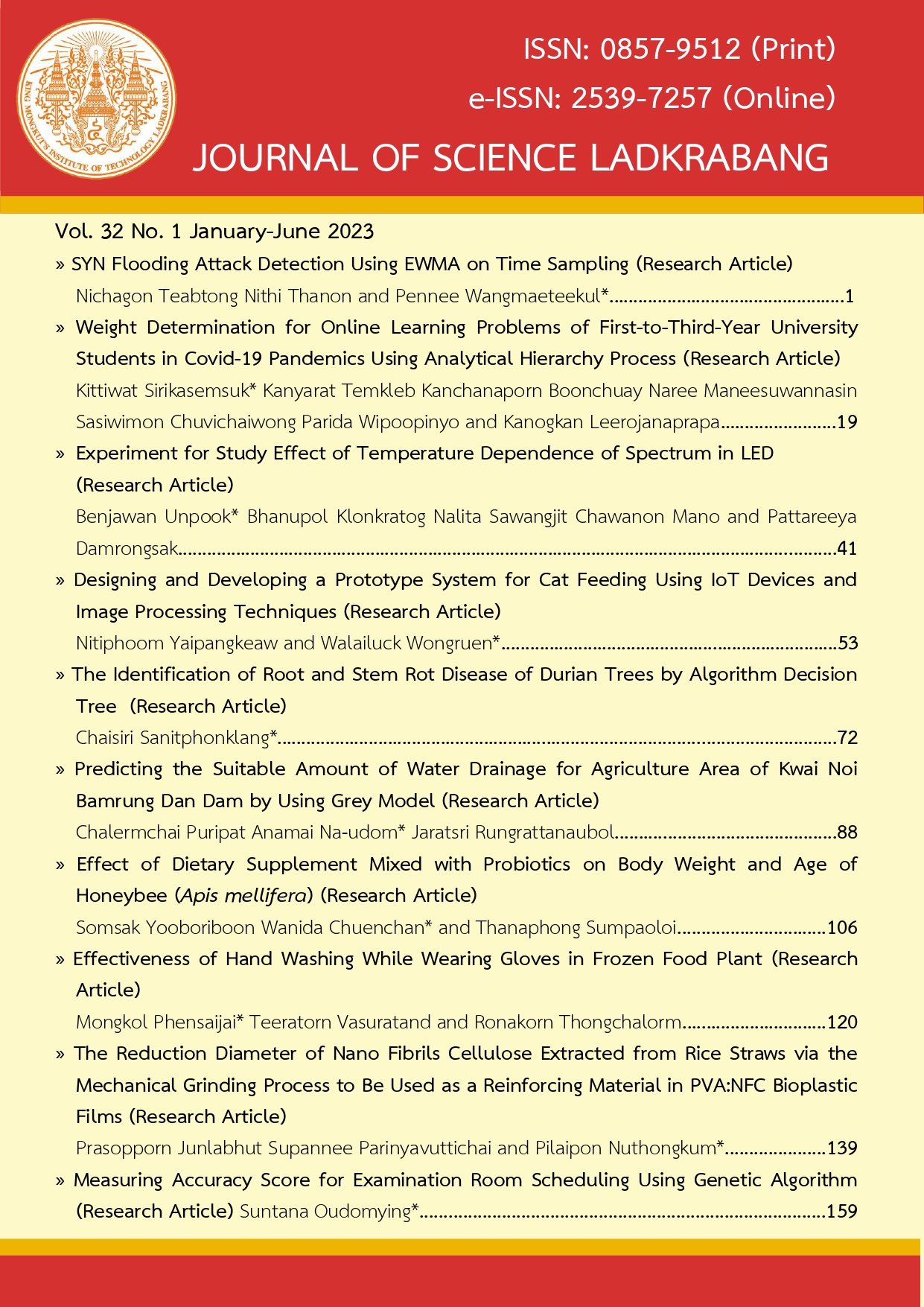Weight Determination for Online Learning Problems of First-to-Third-Year University Students in Covid-19 Pandemics Using Analytical Hierarchy Process
Main Article Content
Abstract
This research aims to study, determine, and prioritize the problems affecting synchronous online learning in the COVID-19 pandemic by applying the principles of the ฤAnalytic Hierarchy Process (AHP), starting from the collection and grouping of online learning problems individually through in-depth interviews with students. The population used in this research during the closed-ended questionnaire was engineering students, 1st-3rd year at the university. Researchers found that the weights of the AHP online learning problems in 1st-3rd year students can be arranged in order of the most important to the least important as follows: the first place was the problem that students cannot do practical experiments; the second was the physical and mental stress; the third was a large amount of work and a short exam time; the fourth was inadequate equipment and internet signal; and the last place was the unfavorable environment. As a result of such a ranking, the responsible people should take on the problem and find solutions in the future. It will be useful for students to study during the next crisis situation.
Article Details

This work is licensed under a Creative Commons Attribution-NonCommercial-NoDerivatives 4.0 International License.
References
World Health Organization. Coronavirus Disease (COVID-19) Questions and Answers. Available at: https://www.who.int/thailand/emergencies/novel-coronavirus-2019/q-a-on-covid-19. Retrieved 14 February 2022.
Mahidol University. What is COVID-19. Available at: https://www.gj.mahidol.ac.th/main/knowledge2/covid19is/. Retrieved 14 February 2022.
Thonghattha, M. 2021. The Situation of online learning management during the COVID-19 pandemic of foreign languages department teachers at pakphanang school in nakhon si thammmarat province. Journal of Lawasri, 5(1), 43-52.
MARKETINGOOPS. COVID-19 Reforms Education around the World! Using New Learning Technology – Thai Universities Teaching Online. Available at: https://www.marketingoops.com/exclusive/business-case/covid-19-reinvent-global-education-system-with-educational-technology/. Retrieved 14 February 2022.
Bangkok Business. What is New Normal? When COVID-19 Push Us to Life Normal, New Way. Available at: https://www.bangkokbiznews.com/lifestyle/882508. Retrieved 14 February 2022.
Brunelli, M. 2014. Introduction to the Analytic Hierarchy Process. Springer.
Mu, E. and Pereyra-Rojas, M. 2017. Practical Decision Making Using Super Decisions V3: An Introduction to the Analytic Hierarchy Process. Springer.
New Zealand Government. 2022. The COVID-19 Virus and Symptoms. Available at: https://covid19.govt.nz/languages-and-resources/translations/thai/prepare-and-stay-safe/information-about-covid-19/the-covid-19-virus-and-symptoms/. Retrieved 6 November 2022.
Sirilak, S. 2022. Classification Data Based on Surveillance Strains and Infectious Mutations. Available at: https://www3.dmsc.moph.go.th/post-view/1708. Retrieved 6 November 2022.
Saaty, T.L. 1980. The Analytic Hierarchy Process. McGraw-Hill, New York.
Saaty, T.L. 1977. A scaling method for priorities in hierarchical structures. Journal of Mathematical Psychology, 15(3), 234-281.
Cirella, G.T., & Russo, A.E. 2020. Sustainable Interdisciplinarity:Human-Nature Relations. MDPI.
Dhivyadeepa, E. 2015. Sampling techniques in educational research. Lulu. com.
Sistek-Chandler, C.M. 2020. Exploring Online Learning through Synchronous and Asynchronous Instructional Methods. Advances in Mobile and Distance Learning (AMDL) Book Series. IGI Global.
Yoosuk, U. and Manisri, T. 2022. Developing location codes and decision support systems or logistics service provider selection. Journal of MCU Social Science Review, 11(1), 58-72.
Tam, M.C. and Tummala, V. R. 2001. An application of the AHP in vendor selection of a telecommunications system. Omega, 29(2), 171-182.
Koohathongsumrit, N. and Meethom, W. 2021. Route selection in multimodal transportation networks: a hybrid multiple criteria decision-making approach. Journal of Industrial and Production Engineering, 38(3), 171-185.
Çolak, M. and Kaya, I. 2017. Prioritization of renewable energy alternatives by using an integrated fuzzy MCDM model: A real case application for Turkey. Renewable and Sustainable Energy Reviews, 80, 840-853.
Maqableh, M. and Alia, M. 2021. Evaluation online learning of undergraduate students under lockdown amidst COVID-19 Pandemic: The online learning experience and students’ satisfaction. Children and Youth Services Review, 128, 106160.
Andreolli, F., Bragolusi, P., D'Alpaos, C., Faleschini, F. and Zanini, M. A. 2022. An AHP model for multiple-criteria prioritization of seismic retrofit solutions in gravity-designed industrial buildings. Journal of Building Engineering, 45, 103493.
Alice, P.S., Abirami, A.M. and Askarunisa, A. 2012. A semantic based approach to organize eLearning through efficient information retrieval for interview preparation. Proceedings of International Conference on Recent Trends In Information Technology (ICRTIT), Chennai, India, 151-156.
Colace, F., De Santo, M. and Pietrosanto, A. 2006. Evaluation models for e-learning platform: an AHP approach. Proceedings 36th Frontiers in Education Conference, San Francisco, CA, 1-6.
Begičević, N., Divjak, B. and Hunjak, T. 2007. Prioritization of e-learning forms: a multicriteria methodology. Central European Journal of Operations Research, 15(4), 405-419.
Chen, Y. and Yang, M. 2010. Study and construct online self-learning evaluation system model based on AHP method. Proceedings 2nd IEEE International Conference on Information and Financial Engineering (ICIFE 2010), Chongqing, China, 54-58.
Shee, D.Y. and Wang, Y.S. 2008. Multi-criteria evaluation of the web-based e-learning system: A methodology based on learner satisfaction and its applications. Computers & Education, 50(3), 894-905.
Yang, M. and Chen, Y. 2010, The research of evaluation system model of web self-learning based on ahp method and the system implement. Proceedings of International Conference on Computer Application and System Modeling (ICCASM), Taiyuan, China, 10-253.
Jeong, H.Y. and Yeo, S.S. 2013. The quality model for e-learning system with multimedia contents: a pairwise comparison approach. Multimedia Tools and Applications, 1-14.
Sharma, R., Banati, H. and Bedi, P. 2011. Incorporating social opinion in content selection for an elearning course. Proceedings of 6th International Conference on Computer Science & Education (ICCSE), Singapore, 1027-1032.
Zhang, L., Wen, H., Li, D., Fu, Z. and Cui, S. 2010. E-learning adoption intention and its key influence factors based on innovation adoption theory. Mathematical and Computer Modelling, 51(11), 1428-1432.
Zare, M., Pahl, C., Rahnama, H., Nilashi, M., Mardani, A., Ibrahim, O. and Ahmadi, H. 2016. Multi-criteria decision making approach in e-learning: A systematic review and classification, Applied Soft Computing, 45, 108-128.

